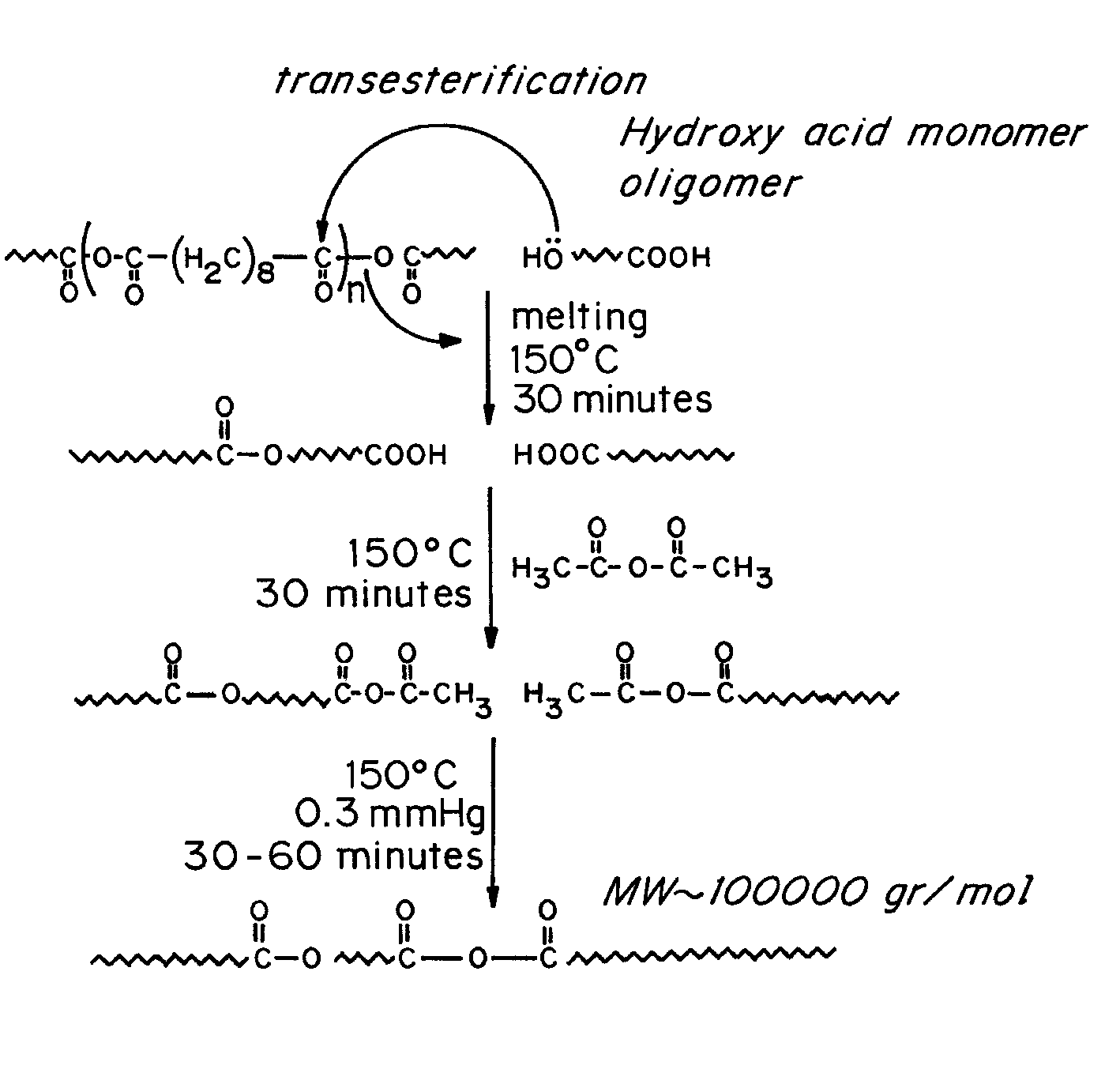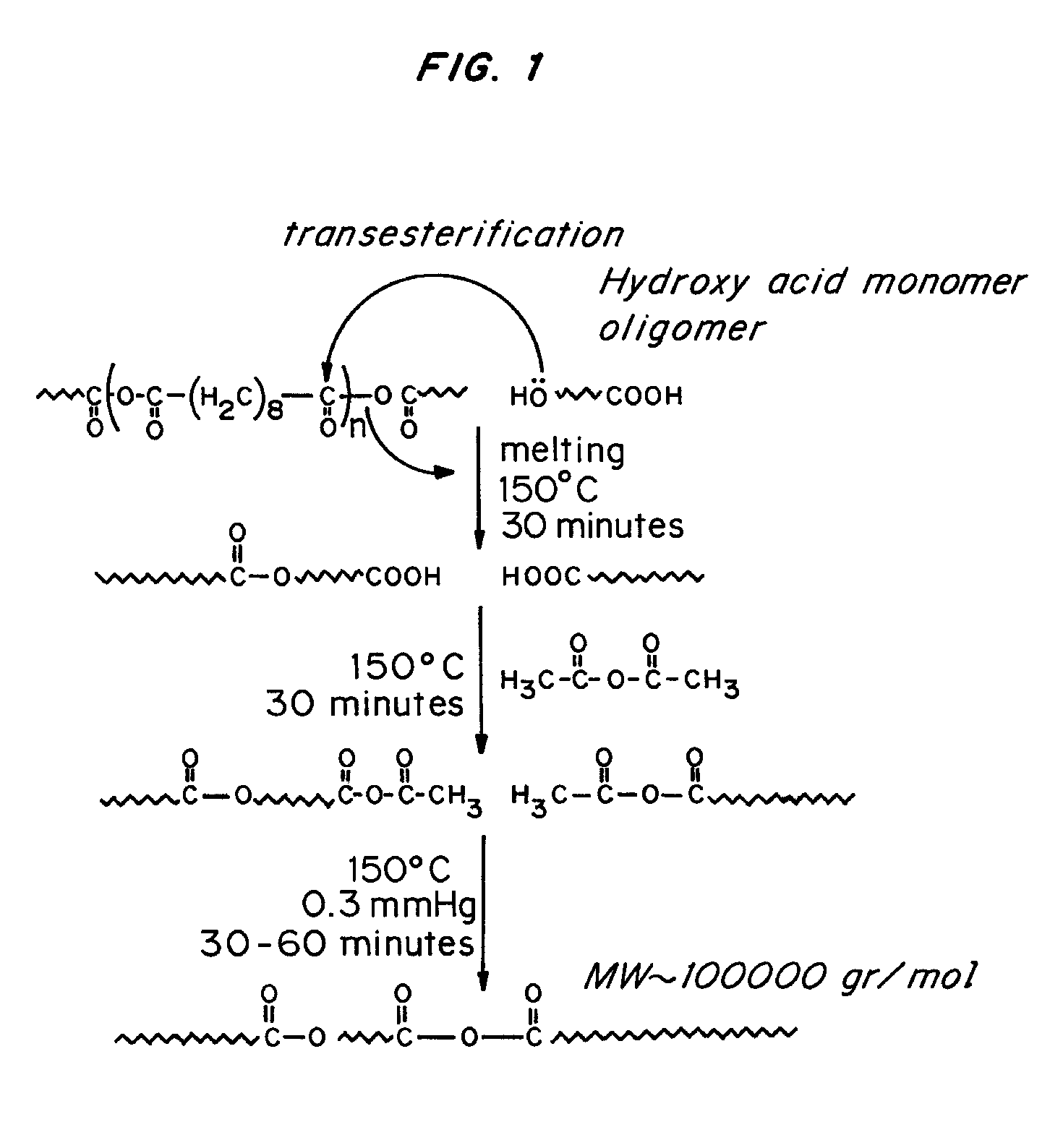Polymeric formulations for drug delivery
a polymer and drug technology, applied in the direction of somatostatins, peptides, drug compositions, etc., can solve the problems of high drug release rate, high erosion rate, and impurities affecting the structure and physical properties
- Summary
- Abstract
- Description
- Claims
- Application Information
AI Technical Summary
Benefits of technology
Problems solved by technology
Method used
Image
Examples
example 1
Purification of Ricinoleic Acid
[0067]Two methods were used to purify ricinoleic acid that is used for polymer synthesis. In the first method, separation by chromatography of the ester derivative of ricinoleic acid and hydrolysis is performed.
Method I: Purification by Chromatography:
[0068]a. Preparation of ricinoleic acid ester: 100 grams of ricinoleic acid (Acros, or Fluka, 0.335 mole) was dissolved in 300 ml of absolute methanol. The mixture was cooled to 0° C. (ice bath) and gaseous HCl was allowed to pass through the mixture during 20-30 minutes. After, the mixture was allowed to stir at room temperature for 2 h and diluted with DDW (500 ml). The combined water-methanol mixture was transferred to 1 L separation funnel and the obtained ricinoleic acid methyl ester was extracted from the mixture with hexanes (200 ml). The hexanes extracts were washed with deionized water (2×100 ml) and with 10% (w / v) NaHCO3 and treated with anhydrous MgSO4, filtered and evaporated to dryness.
[0069]...
example 2
Synthesis and Characterization of -alkyl Ricinoleic Acid Terminated Polyanhydrides
Materials:
[0080]Ricinoleic acid, (85% content, technical, Fluka, Buch, Switzerland), acetic anhydride (Merck, Darmstadt, Germany), Meth-Prep II, methanol esterification reagent (Alltech, Deerfield, Ill.), were used in this study. All solvents were analytical grade from Aldrich (Milwaukee, Wis.) or Frutarom (Haifa, Israel).
[0081]Infrared (IR) spectroscopy (Perkin Elmer System 2000 FT-IR) was performed on monomer, prepolymer, and polymer samples cast onto NaCl plates from dichloromethane solution. Thermal analysis was determined on a Metler TA 4000-DSC Differential Scanning Calorimeter (DSC), calibrated with Zinc and Indium standards, at a heating rate of 10° C. / min. Molecular weights of the polymers were estimated on a Size Exclusion Chromatography (SEC) system consisting of a Spectra Physics (Darmstadt, Germany) P1000 pump with UV detection (Applied Bioscience 759A Absorbance UV detector) at 254 nm, a ...
example 3
Synthesis of Oleic Acid Terminated Polyanhydrides
[0096]Oleic acid was mixed with the following diacids: sebacic acid, ricinoleic acid maleate, polyethylene glycol dicarboxylic acid (Mw=1000), isophthalic acid, terephthalic acid, fumaric acid, poly(lactic acid) dicarboxylic acid (Mw=1700), poly(lactic-glycolic acid) (Mw=1500), and polycaprolactone dicarboxylic acid (Mw=2000). The amount of oleic acid increased from 50% by weight to 80% and the mixtures were dissolved in acetic anhydride (1:10 w / w) and refluxed for 30 min. The solvent was evaporated to dryness and the residue was vacuum polymerized at 150° C. for 2 hours (0.1 mm Hg) to form a viscous melt which solidified at room temperature. The melting points of the various polymers ranged from 30 to 65° C.
[0097]Polymers with mixed terminals were prepared by mixing the oleic acid with non-linear or linear mono carboxylic acids to obtain polymers with different properties.
PUM
| Property | Measurement | Unit |
|---|---|---|
| Percent by mass | aaaaa | aaaaa |
| Weight | aaaaa | aaaaa |
| Composition | aaaaa | aaaaa |
Abstract
Description
Claims
Application Information
 Login to View More
Login to View More - R&D
- Intellectual Property
- Life Sciences
- Materials
- Tech Scout
- Unparalleled Data Quality
- Higher Quality Content
- 60% Fewer Hallucinations
Browse by: Latest US Patents, China's latest patents, Technical Efficacy Thesaurus, Application Domain, Technology Topic, Popular Technical Reports.
© 2025 PatSnap. All rights reserved.Legal|Privacy policy|Modern Slavery Act Transparency Statement|Sitemap|About US| Contact US: help@patsnap.com



